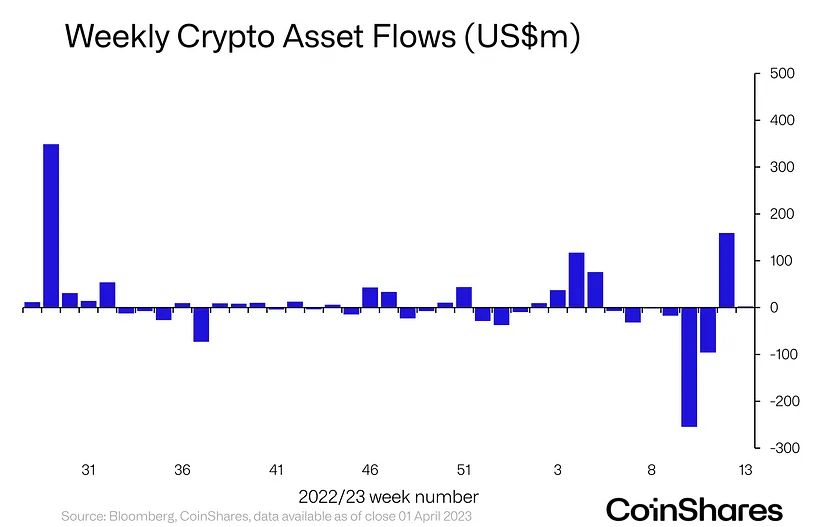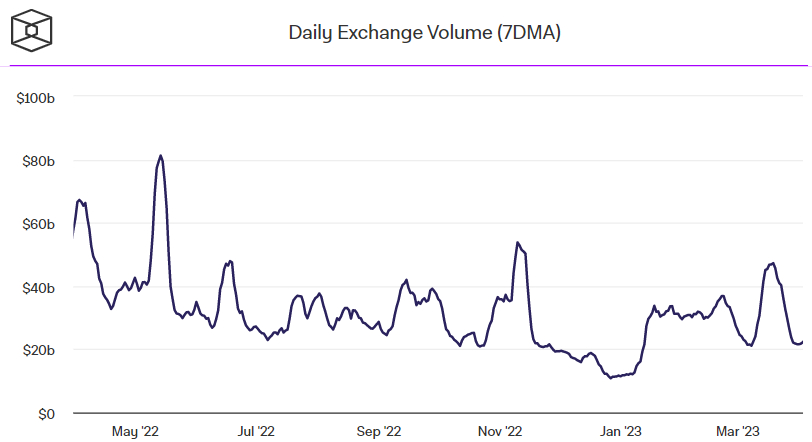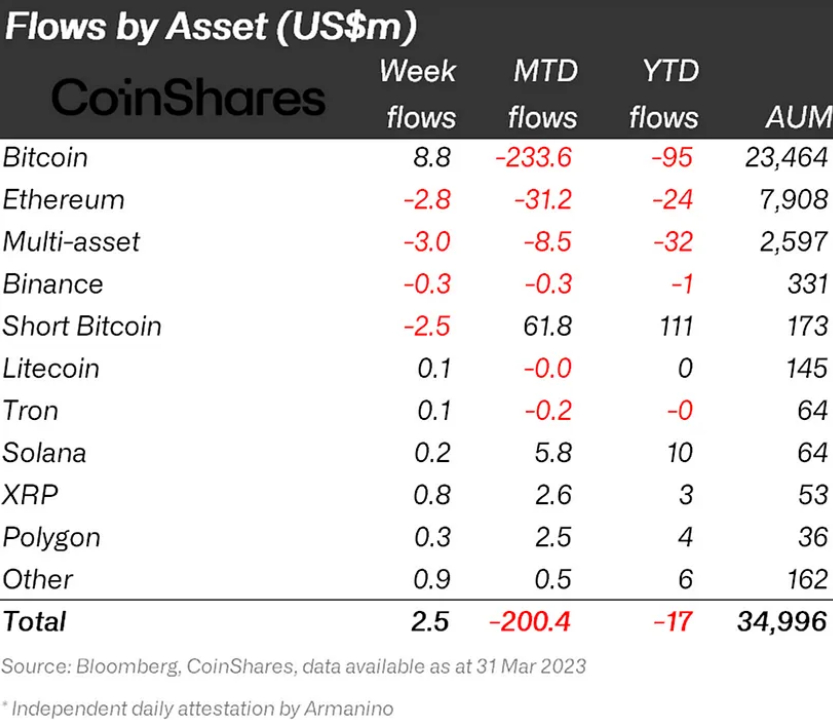Investors Continue to Buy Bitcoin, Latest Fund Flow Report Shows – Here’s Why BTC May Dominate Institutional Crypto Demand


A week after digital asset investment products saw their biggest weekly inflows since July 2022 at $160 million, the pace of inflows has almost stopped, according to the latest Digital Asset Fund Flows report released on a weekly basis by CoinShares.

According to the crypto data analysis firm, “digital asset investment products had inflows totaling US$2.5 million, with trading volume in investment products falling 33% compared to the previous week”.
“This was reflected in the broader bitcoin market where trading volumes on trusted exchanges fell by 61%, with both data points suggesting much less participation in the crypto market compared to the previous week,” CoinShares continued.
In fact, according to data presented by The Block, the seven-day moving average of volumes was about $22.5 billion as of Monday, down from about $46 billion in mid-March.

Lower volumes come at a time when Bitcoin has been going sideways in the $28,000 area for some time now, while other cryptocurrencies have also been subject to range-bound conditions.
Bitcoin is enjoying decent inflow
Looking under the hood, sentiment is actually more positive than one might think for Bitcoin.
The world’s largest cryptocurrency by market capitalization had $8.8 million in inflows, while short Bitcoin investment products had outflows of $2.5 million.
Bitcoin’s rally has left the dollar value of total assets under management “at its highest since the June 2022 collapse of 3 Arrows Capital at $23.5 billion,” CoinShares noted.

Ethereum and multi-asset products had a combined outflow of $5.8 million, while smaller coins such as Litecoin, Tron, Solana, XRP and Polygon all saw modest inflows.
According to CoinShares, “inflow into short Ethereum (US$0.5 million) suggests investors remain concerned about the upcoming Shanghai upgrade that will enable un-staking (return distribution)”.
Data from alternative crypto analytics firm CryptoQuant, which instead refers to on-chain data, shows that the amount of Bitcoin held by digital asset managers, which can include trusts and exchange-traded products, has increased in recent weeks in the wake of the US bank failure in mid-March.

According to CryptoQuant, fund holdings stood at 692,000 BTC (worth around $20 billion at current prices) as of Sunday, up from around 688,000 BTC on 14.th of March.
At current levels above $28,000, Bitcoin’s price has risen sharply since a brief dip in mid-March to levels below $20,000.
Analysts have put the cryptocurrency’s strong rally down to 1) safe-haven demand amid concerns about a US (and global) banking crisis and 2) bets that the Fed is almost done with its tightening cycle and could soon cut interest rates, which has weighed on US bond yields and the US dollar (and increased crypto in general).
According to CryptoQuant’s data, increasing demand from investors in Bitcoin trusts and exchange-traded products must have played a role in the price rise.
A greater proportion of Bitcoin moving towards these types of investors suggests growing institutional adoption, which has previously been touted as a key long-term driver of crypto price appreciation.
Here’s why Bitcoin could dominate institutional crypto demand
Bitcoin may disproportionately dominate institutional demand in the next bull market cycle.
It’s not just because Bitcoin, the world’s first, oldest and safest cryptocurrency (at least according to many proponents), is seen as the best option against a traditional banking crisis in the financial system.
It’s also because Bitcoin is mostly completely clear when it comes to regulations, while many other cryptocurrencies are not.
Take the US Securities and Exchange Commission. They have publicly argued that Bitcoin is a digital commodity and therefore not under their regulatory oversight, but that most other cryptocurrencies are securities.
These include crypto networks like Ethereum, which offer returns to stakers of the Ether token, which the SEC likely sees as a security.
And it’s not just staking that puts a cryptocurrency at risk of being considered a security.
The way it was originally distributed is also a risk, as Ripple found out in 2020 after being sued by the SEC for the distribution of XRP tokens, which the SEC claims was an unregistered securities offering.
However, the momentum seems to be Ripple winning this lawsuit right now.
Bitcoin seems to be the only cryptocurrency that is completely clear right now (although for the same reasons there is also a very strong case for the likes of Litecoin and Dogecoin to be digital goods as well).
That means investors may prefer to invest in Bitcoin over some of the big smart contract-enabled, proof-of-stake-powered layer-1 blockchain rivals like Ethereum, Cardano, Solana, etc.
























